Paranoia Rebooted by Hostile V
FRIENDS DON'T LET FRIENDS HAVE NOSTALGIA
Original SA post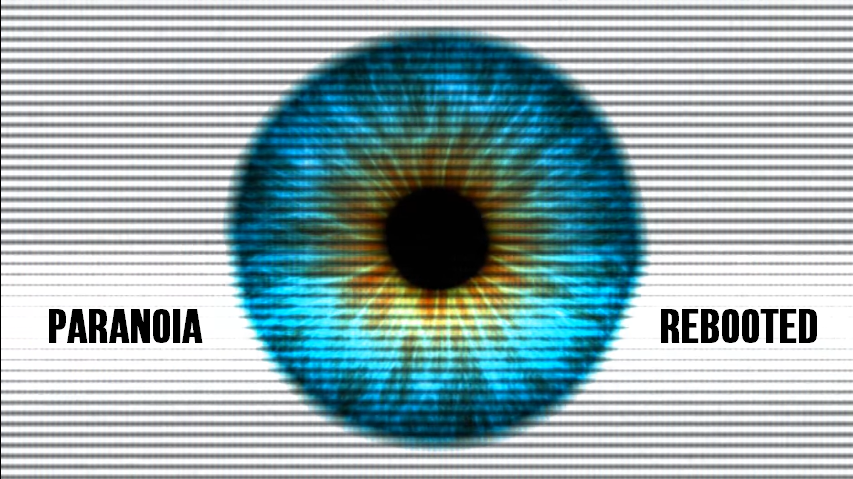
FRIENDS DON'T LET FRIENDS HAVE NOSTALGIA
Hi again. How are you? I am fine, thank you for asking. Today we're here to sink our teeth into the latest edition of Paranoia, a series that's pretty near and dear to my heart. My first ever F&F was an awful rambling screed about how much I enjoyed the Internal Security expansion for the 25th anniversary edition and the newest version of Paranoia doesn't really get talked about much, so I figured hey, why not!
It's bad.
See you next time! I should probably finish something I'm working on.
Okay but seriously it isn't good, to which a reasonable RPG fan of taste would say "duh?". And that reasonable fan of taste would be correct! Always approach some Kickstarted tabletop games with a healthy degree of skepticism and questions you'd like answered before you give any credit card info. The problem is that I'm dumb as hell, saw Paranoia and immediately decided "I WANT IT".
I like Paranoia a whole lot. It is by far one of my favorite games and settings; I knew about the setting back in the far-off time of 2005 when I was a shitty teen who listened to Iron Maiden and a lot of heavy British rock-metal and read a lot of web comics. I knew more about Paranoia before I ever really paid attention to D&D and certain editions of Paranoia (okay let's be honest, XP) continue to be up there in my heart and mind. It helped that I had taken a gigantic shine to Orwell's 1984 due to high school lit classes and I was a shitty teen who was a huge fan of social satire but also dumb enough to not be picky about my consumption of media and what was good media. Anyway I'm getting a little too long in the tooth. The point is that I liked the world of Alpha Complex, the absurdity and the bureaucracy and the clones struggling against the system. You go find trouble and shoot it.
This is probably the groggiest you're ever gonna see me be. Don't mix nostalgia and hobbies, that only makes it worse when something ain't great.
In 2004 Mongoose got access to the Paranoia license and came up with Paranoia XP with most of the original crew from West End Games writing XP. 25th Anniversary came out in 2009 and Mongoose pulled all the remaining books and PDFs for XP. They did the same thing again in 2014 for Paranoia Rebooted (I'm calling it this due to a lack of a more proper name to my knowledge). I wasn't able to get some of the books I was looking for and I recognized one name attached to the Kickstarter (I like Grant Howitt's stuff) so I figured "an update? Sure, why not".
It's bad. Let's find out how it's bad.
PARANOIA REBOOTED
Core Rebooted is called Red Clearance edition and comes with a player's handbook, a mission guide, a GM guide, character sheets and a list of cards. That's right, Paranoia now requires cards to do stuff. O brave new world, That has such design choices in't! I joke but hoo doggy there are some Changes. We'll be starting with the player's handbook, then the cards, then the GM guide and ending with the mission guide. There is no good starting point 'cuz none of it is good but let's do this all authentic-like, starting with the player perspective before shifting into the GM Zone.
PLAYER'S HANDBOOK
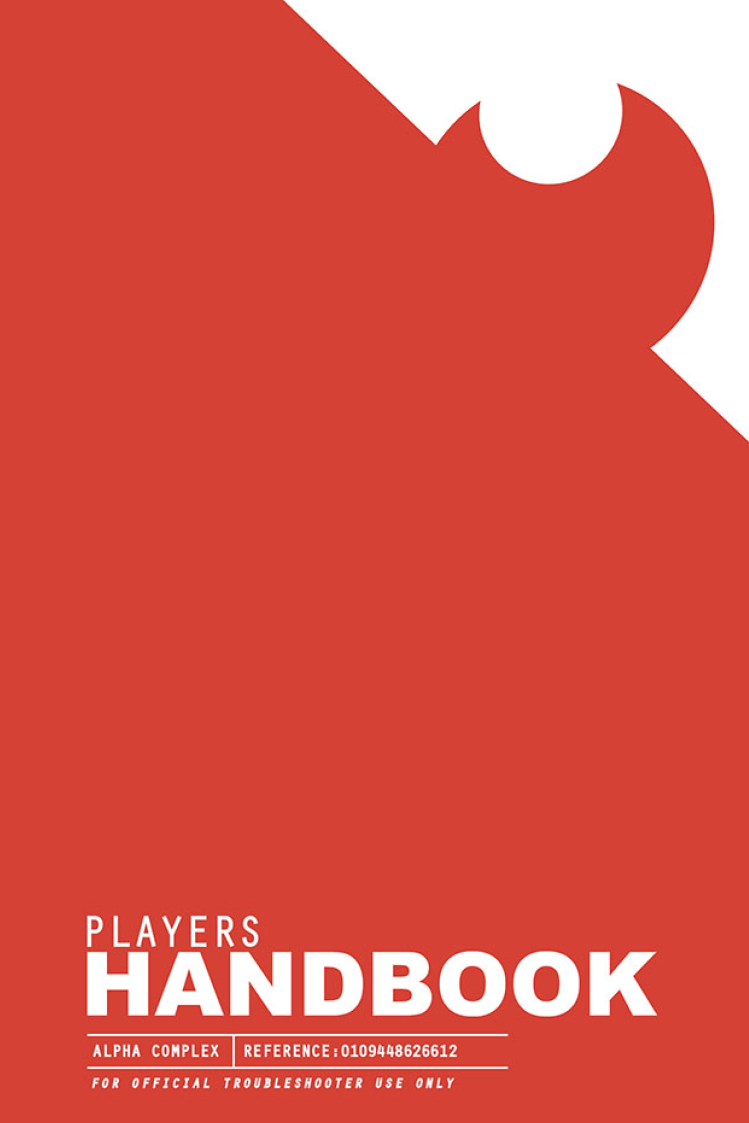
Okay I'm lying, there are small pieces of things I like. I really like the minimalist artwork for this cover. It's really nice and striking and prepare for this design aesthetic to never be used again. I'm going to be using the eyeball art up top (which I made myself and it shows) for this entire rundown because otherwise the header art is going to be this:

but it has a different subtitle each time for each book. Speaking of art. There is a new art style for Paranoia and I am. Not a fan.
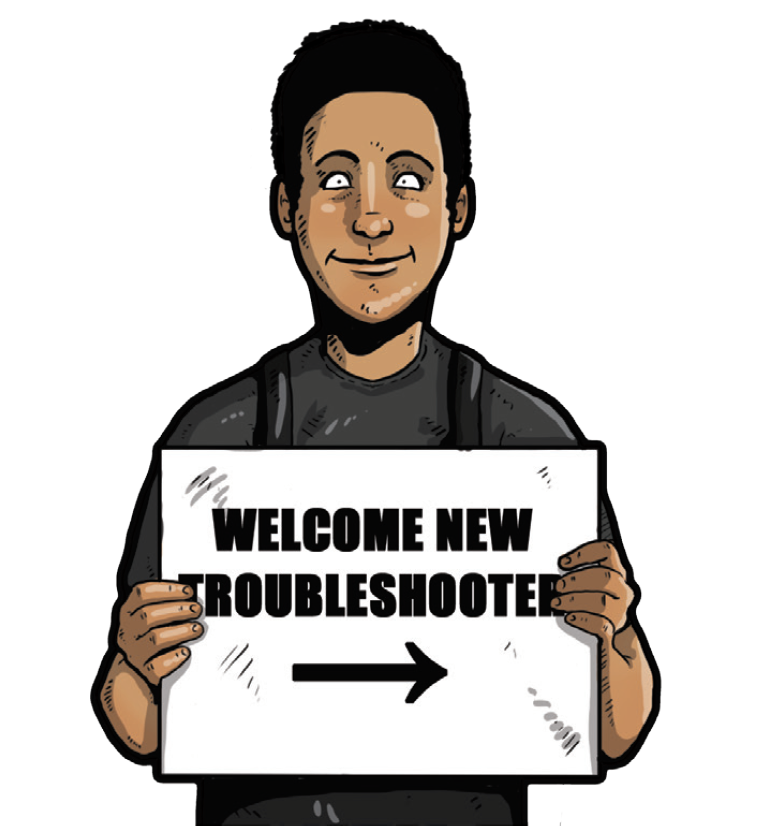
Like, just.
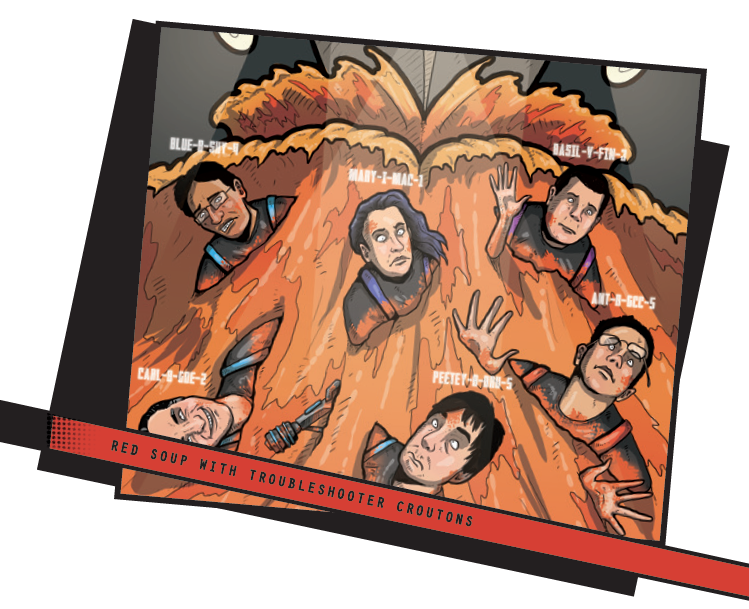
All of the art is tilted at an angle through the book and they all have those beady little eyes with the dot pupils and just ugh, a friend compared them to Cracked article art and he's super not wrong and I hate that he's right.
Ugh. I don't know why this was the art style they went with? It's weird. There are many weird and questionable decisions I don't understand because I stopped paying attention to updates when they went a few years over in production. Also: you may notice pun names are back. They never went away but now they're officially back.
Section One: How To Be A Troubleshooter
Or more accurately, how to read your character sheet. Let's take a look and go over some core terminologies.
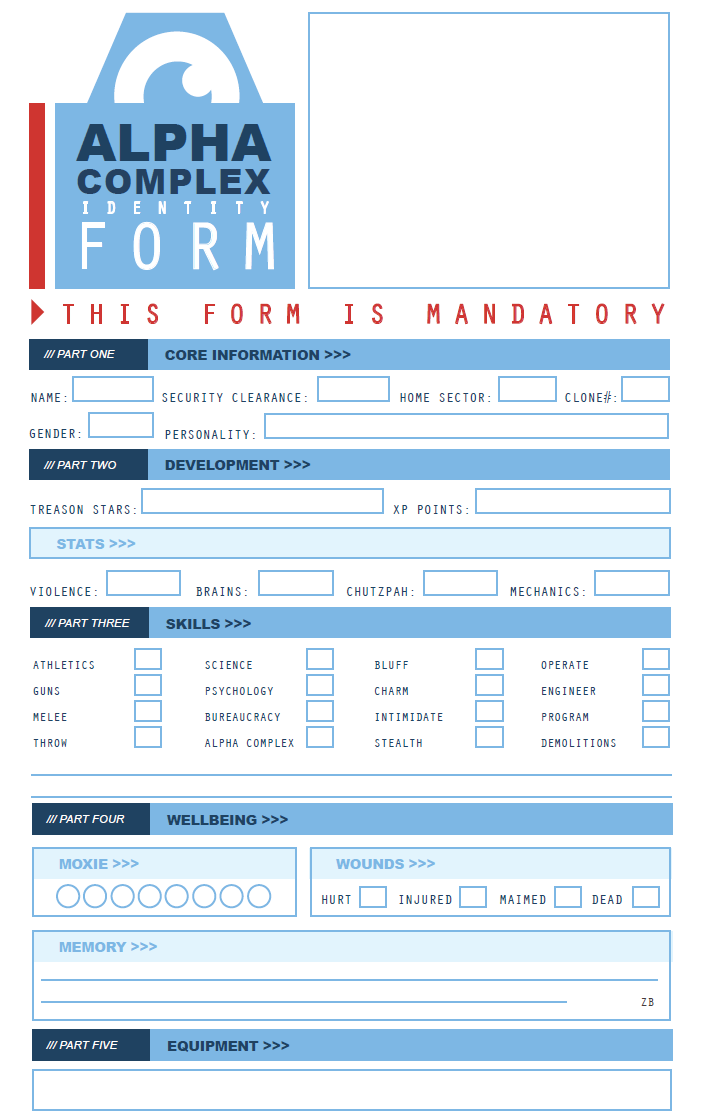
In contrast to previous editions, Rebooted cuts Skills and Stats way back, a decision I don't disagree with. Health and damage has also been simplified. Let's get a little detail though.
- Personality is actually a somewhat important thing that has some more explanation in character creation.
- Treason Stars are the replacement for treason points. They basically act like stars in GTA and everyone can see how many stars you have. Hit 5 and everyone has a free license to murder you. There are problems with the treason system we'll get into later.
- XP Points involve a whole system that is, uh, badly designed. I haven't hated a XP system in a while the way I feel about how this handles XP.
- Stats range from 0-4 with 4 being the best you can be.
- Skills range from -5 to +5. The skill system is weird and took me a bit to understand how exactly negative point skills function but it sure was a design decision. "Alpha Complex" refers to knowing details about the Complex like floor plans and important people/features, "Operate" involves using heavy machinery and "Engineer" involves building/tinkering with machinery. It's hard to tell but the lines beneath the skills are for skills you possibly pick up somewhere along the line.
- Moxie is both Fate Points and Sanity Meter. Yeah.
- Memory has to do with the fact that clone brains are much more machine than they ever were. The standard MemoMax system of black-boxed memories and PDC smart phones are out the window. The brain of a clone now hosts enough networked hardware to allow their eyes to act as cameras and their grey matter as computers. Memory indicates things installed on your clone's brain such as desktop backgrounds, targeting software and neurochemistry-stabilizing happiness programs.
This is the part where knew that I would hate this game.
quote:
Every group of players will have a dynamic with friendships, likes and dislikes, favourites, animosities and simmering resentments. A party of characters should have a similar dynamic and most character creation systems don’t model that at all. So Paranoia has a party-creation system – each player builds a character to play in the game, but you’re able to affect the making of other people’s characters and that creates tensions and links within the group that will transfer into play, all without tearing the group apart in petty feuds and minor incidents of attempted homicide... or at least that’s the plan.
Default character creation is a group-based pre-game affair either as a session zero or right before you launch into the meat of play. Creation is broken down into six steps: Define, Skills, Stats, Optimizing, Details, Redefine. But first, a sidebar on gender and identity in Alpha Complex.
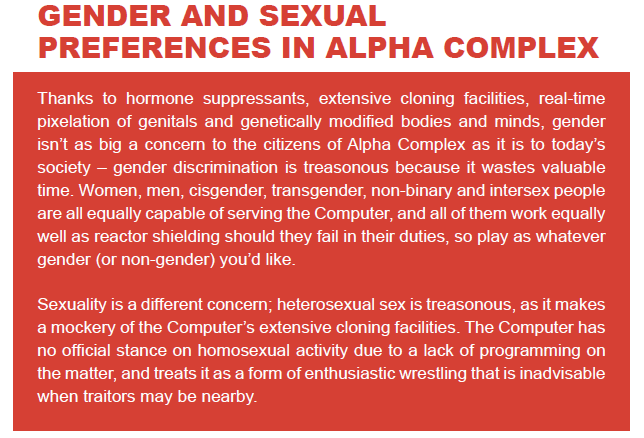
I legitimately appreciate the first part, even if it's wrapped up in a bit of bad wry humor. The second part I'm not so sure about. The entire sidebar is a pretty important and inclusive statement to make and then they undercut the sentiment with a cheap joke about gay sex. The first half of this sidebar is actually the thing I appreciate the most about this new edition and even then I would super love it if it was not attached to this game. Anyway, it's fine to make a character you're comfortable with and that's good because the rest of character creation is uncomfortable especially if you do this in group-mode.
Define
Pick a name, appearance and gender. We'll be playing along at home so our sample Troubleshooter will be Karen-R-SLN-1, agender masculine, he/him/his pronouns, androgynous but athletic body. There is no pun name here, we're doing this old-school. Write three adjectives under personality that describe your character. Generally speaking they will be positive ones. For example: Karen is Tenacious, Tough and Attentive.
Skills
- The player (A) to the left of the GM gets to pick a skill they get at level 1.
- The player on their left (B) receives that same skill at a -1 before selecting another skill which C then gets at a -1.
- Each skill can only be chosen once a round and you are not allowed to select a skill you already have a rating for.
- Quote: "Keep going round the group, slowly building the simmering resentments – ‘What do you mean, I’ve got a negative guns skill?’ until everyone has one +1 and one -1 skill. Don’t worry, simmering resentments are good! Interesting stories arise from conflict, so anything that is going to provoke conflict is good."
- Repeat until everyone has five positive and five negative skills. Some skills will end up being zero even with a large crew of players.
Karen's skills:
- Athletics 0, Guns 3, Melee 2, Throwing -1
- Science 1, Psychology -3, Bureaucracy -2, Alpha Complex 5
- Bluff 0, Charm -5, Intimidate 4, Stealth -4
- Operate 0, Engineer 0, Program 0, Demolitions 0
Add up the number of positive skills in each stat group for four numbers and ignore the negatives. In Karen's case, that comes out to 2, 2, 1 and 0. Then the person to your left, the person who you have been repeatedly giving negative skills, selects where those go.
Karen's stats: Violence 0, Brains 2, Chutzpah 2, Mechanics 1.
Optimizing
You have most likely been dealt a bad hand in two different forms. Now you can mutilate your character to get what you actually want. Skills can be raised by permanently reducing your total Moxie pool at a 1:1 exchange for a minimum of 3 maximum Moxie. Stats can be raised by burning clones with a 1:1 exchange down to starting play on clone #6. Can't raise a Stat above 3, can't raise a skill above 5. The game fully admits that spending too much Moxie at this stage is a bad idea. No shit. It's your Sanity Meter. Burning your clones is also a particularly dumb idea. I will be doing neither of these.
Details
Find out your clearance. The GM then passes out a Secret Society card and a Mutant Power card to each player. Some cards are blank. It is completely possible to actually play Paranoia without a mutant power or being in a secret society. We're just going to ignore this for now because, well, that's a whole other kettle of fish. Troubleshooters also get a Red jumpsuit and a Red laser pistol. Please note how I did not say "Red Reflec armor and a laser pistol without a barrel". Write this down for the test later.
Redefine
The player to your left, who you have been fucking over, gets to flip one of your positive adjectives into an antonym or some kind of opposite. The recipient of the flip is allowed to try to bribe the flipper using in-game resources and favors. I don't know why you would because this legitimately has no mechanical bearings. For the sake of Karen, let's say Attentive gets flipped to Inattentive. He daydreams a lot and has to be pointed at problems that need breaking.
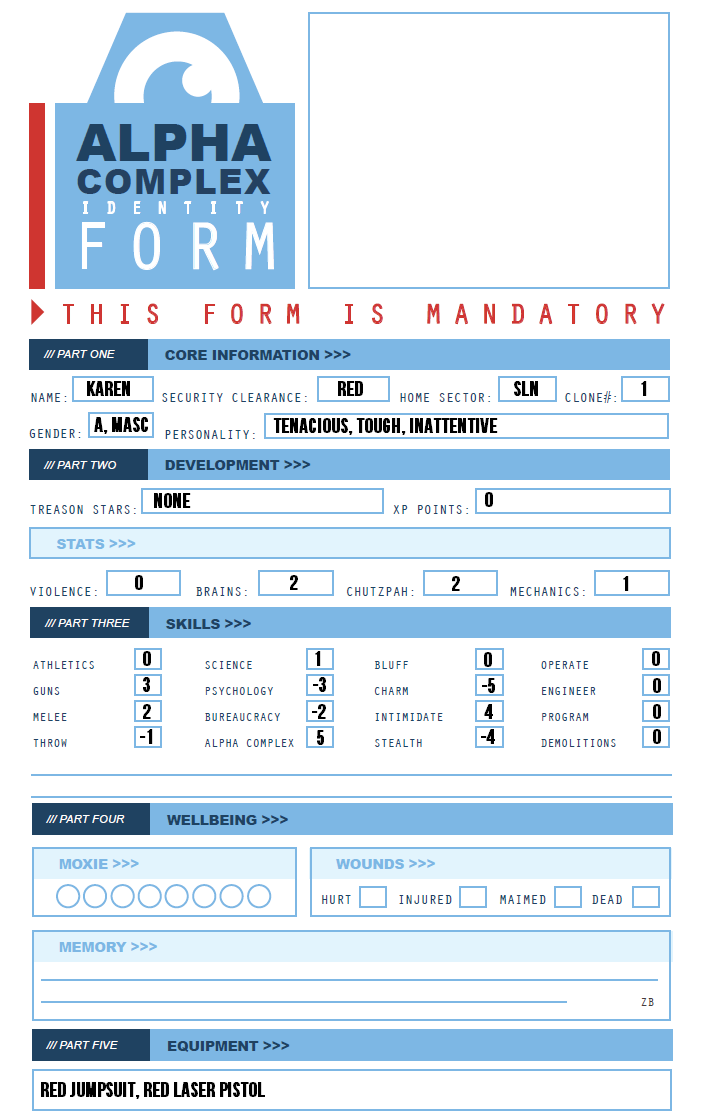
Now, the terrible truth: I clearly didn't design Karen in a group setting. I designed him using the optional Solo Character Creation Rules. These come right after the group creation rules but the game admits "they are not nearly as fun as using group play, but I mean, like, I guess you can use these, sorta, maybe, if you don't like the original rules, but they're not as fun! C'mon. C'moooooon. C'mooooooon."
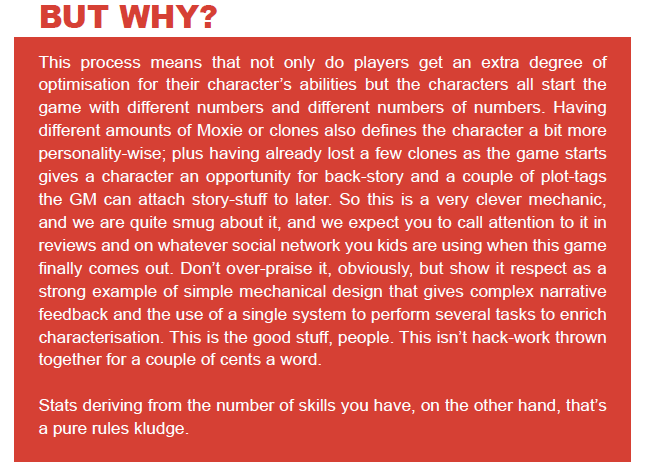
Honey, please, mind your goddamn tone.
Solo Character Creation Rules
- Define remains the same.
- Skills are hand-selected. Five have positive rankings, five have negative.
- Stats are calculated using the same means (tally the amount of positive skills) but instead of choosing where they go they're shifted over one to the left. The score resulting from Violence goes to Brains, Brains goes to Chutzpah, etc.
- Optimizing remains unchanged.
- Details remains unchanged.
- Redefine is done by the GM who gets to pick one adjective to flip.
The book keeps doing this and the tone makes it infuriating. I can handle there being Options. Options are fine, it's always better than being inflexible with your design process. The problem is that Option 1 is always posited as being the Best thanks to tone and Option 2 always feels like an afterthought. It reads like an obvious edit or emotional manipulation that's swinging between "HOW FUCKING DARE YOU WANT SOMETHING DIFFERENT" or "I am apologizing and one sniffle away from crying so please take pity and accept this other option" at all times. I understand none of the design decisions behind this besides "we liked the pithy humor of Paranoia and this is our attempt at emulating it".
Which is a well I will keep returning to over and over. It reads the humor on a surface level and utterly fails at encapsulating understanding of the humor like your younger brother after watching comedians from the 90s. The jokes of "but we're great game designers" in XP and earlier editions was always written with the subtext of "we're taking the piss out of ourselves" due to phrasing and the fact that there were many forms of character creation (point buy, random rolling, assigned stats) that were used to cover the bases. This system is legitimately designed to foster animosity and negativity at the table before play starts and then the writing comes across as infuriatingly smug due to the context.
THOUGHTS
I really only have two thoughts to share at this juncture. One is a glimpse of the failing of mechanical design to come and the other is an indication of the kind of game they're selling to you.
First is the fact that the previous editions of Paranoia had a small but significant rule. All Troubleshooters go to training to know how to use their guns. In XP this is reflected as a mandatory +4 to Energy Weapons with no downside attached, it's a free buff. XP is a roll-under system and you're pretty likely to have 7s in a lot of skills. Having one skill give you a little bit of a fair shake at using it is great, especially because it's giving you one relatively reliable thing for you and the party to do: resort to violence, blast the shit out of your problems.
Rebooted does not do that. It's generally a crapshoot what you'll be able to do unless you go solo or manage to pick one of the skills you want to be good at. You're not guaranteed to have the fallback of violence, which is an issue when this is a game that relies heavily on combat as we will shortly see.
Second is the fact that Paranoia has...a mood. Some of it depends on what mode you're playing, but the general feel of Paranoia is to look out for your best interests, seize advantages and occasionally take a pie to the face for your scheming and self-serving. This is a tone that's repeatedly expressed either in passing or said to your face. You want to be smart and scheming but you want to have fun with it.
Rebooted does not have that mood. From the word go it's a far more hostile "everyone else is a fucker and I hate them" atmosphere. They try to put it in this veneer of "we're fostering competition!". I have seen games like Diplomacy or Catan or other less actively aggrandizing games whip people into a cold, calculated rage or a red-faced screaming fury. I have seen Pathfinder Society turn into a shouting match. Any game that intentionally rubs people against each other for pre-adventure chafing and agitation will set the mood of genuine hostility for the session to come and that's a pretty dangerous thing to do. And this is the game they want to sell you on. Will every group crash and burn? Probably not. At the very least it's an annoyance. And that's still not a great foot to start on.
Next time: Mechanics, where the regretful decisions continue and we understand how exactly the game functions.
BASIC MECHANICS
Original SA post
BASIC MECHANICS
Or
Extruded d6 Dice Pool-Flavored Snacky Time Kelp Chip Product
The backbone of the system in building a dice pool called a NODE (which stands for Number Of DicE). Anything that you could do that is challenging requires you building a NODE from a Stat and a Skill relevant to the task at hand. Roll the dice and count any 5s or 6s as successes; it’s your bog-standard pool of d6 mechanics with a few twists but you basically want to argue that your NODE is good for the roll based on the moment. For example: your average use of a laser pistol would be Violence+Guns. Our Troubleshooter Karen has a 3 in Guns, but he’s not super great at using Violence thanks to chargen shenanigans. If Karen wanted a bigger pool of dice he would have to use his Guns skill creatively such as declaring he was aiming carefully for a bank-shot or distracting the target with a shout before shooting. The GM is always allowed to veto this suggestion and other players can suggest what would work as well. The GM is also free to add or remove dice based on ingenuity, circumstances, equipment, solar eclipse, etc. It’s a system you’ve seen before so let’s look at the twists.
Negative Skills
Everyone has five skills they’re bad at but you’re still allowed to roll them. Using a negative skill lets you amass a pool of dice as if it was a positive skill, so if Karen was going to try to Chutzpah+Charm on someone that would still be a good pool of 7 dice. The drawback of using a negative skill is that any roll on this pool that isn’t a 5 or a 6 eats a success per non-success. With a 7-dice pool, Karen is likely going to get 2.3333 successes and 4.6667 non-successes. The book says negative successes should be considered by the GM as an invitation for Fun Stuff to happen. The average player is probably going to just write that stat off as dead and never bother to improve it or use it. A better system would be to remove the non-success negation aspect and instead just let the players do things at a cost PBTA-style.
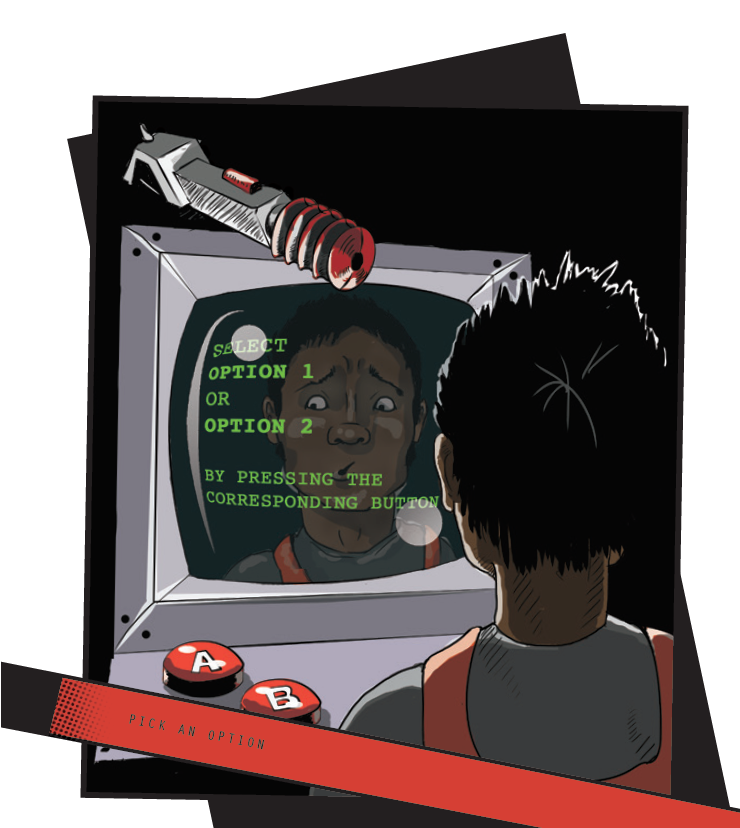
"Just think before you answer/there is no correct answer/so don't shoot/I'm a man"
Computer Dice
Say Karen wants to disable a machine by beating on it with a spanner. That would likely be a Violence+Operations check, but Karen has a 0 in Violence and a 0 in Operations, making that a NODE of 0. To get around characters being unable to do certain tasks, all dice rolls also roll what is called the Computer Dice which is a special d6 with an icon of Friend Computer on it. Karen’s Brains+Guns pool would be NODE 5+1 Computer Dice, Chutzpah+Charm would be NODE 7+1 Computer Dice and his Violence+Mechanics pool would be a flat 1 Computer Dice. The Computer Dice can be used to gain successes, but if it comes up with the Friend Computer icon…that means that Friend Computer has decided to butt in on whatever you’re doing to try and help. And FC sure has a bad grasp of what help means. Regardless of success or failure on the roll, FC will generally immediately broadcast something distracting and startling into your brain/vision that is relevant to the moment at hand. The book has the example of an internal schematic of a bomb’s wiring mechanism blocking out a Troubleshooter’s vision the moment he cuts the wire. Alternately, the Computer Dice is an excuse to shake up the moment and make something else chaotic happen that rattles the Troubleshooter. The shock of the sudden intrusion of helpfulness/whatever else costs the Troubleshooter a Moxie Point. Speaking of, Moxie!
Moxie Points
Moxie represents your stress levels but I’m going to keep referring to it as a Sanity Meter. Your maximum Moxie is determined by character creation which is why it’s generally a bad idea to start with three. While you may (will) be lacking in higher Skills, Moxie also doubles as Fate Points/Willpower. You can buy extra dice for a roll at a 1:1 ratio, you can reroll an entire pool of dice once after a failure and Moxie is also used to activate Mutant Powers. Moxie is also automatically lost whenever Friend Computer intrudes due to a roll on the Computer Dice or whenever a Troubleshooter witnesses something that shocks and shakes them (upsetting images, scenes of carnage, taking heavy damage, doing bad things, stuff that makes them feel unhappy).
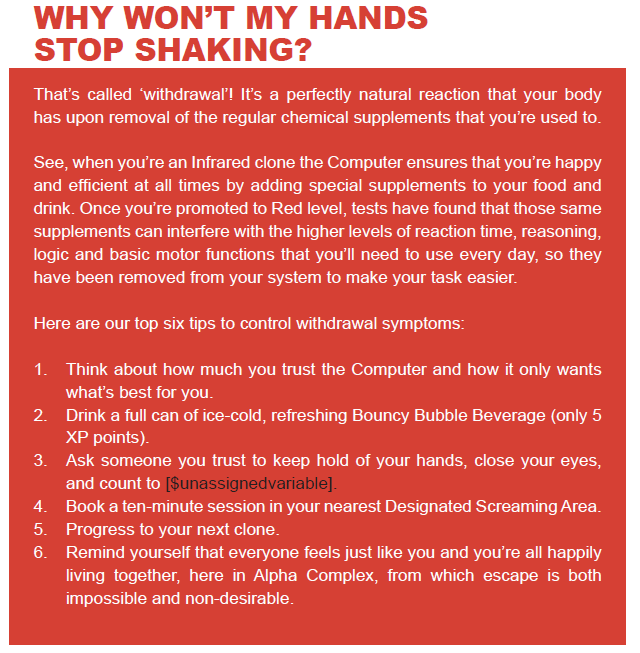
Fortunately, it’s not too hard to regain Moxie because any Moxie spent after character creation can come back. A solid sleep and a good breakfast will restore one Moxie. If you don’t have that kind of time, the Happiness Officer can make a Brains+Science roll vs. a TN of 2 to administer a stimulant that restores one Moxie per extra success. If you need it ASAP and have the resources to burn or you don’t trust anyone in your party with a needle, there’s always paying 50 XP per point of Moxie to have happy thoughts/neurochemistry stabilizers downloaded directly into your brain. If you need it ASAP and don’t have the resources at all, there’s always dying. If you die with at least one point of Moxie left, your next clone comes back with all Moxie restored.
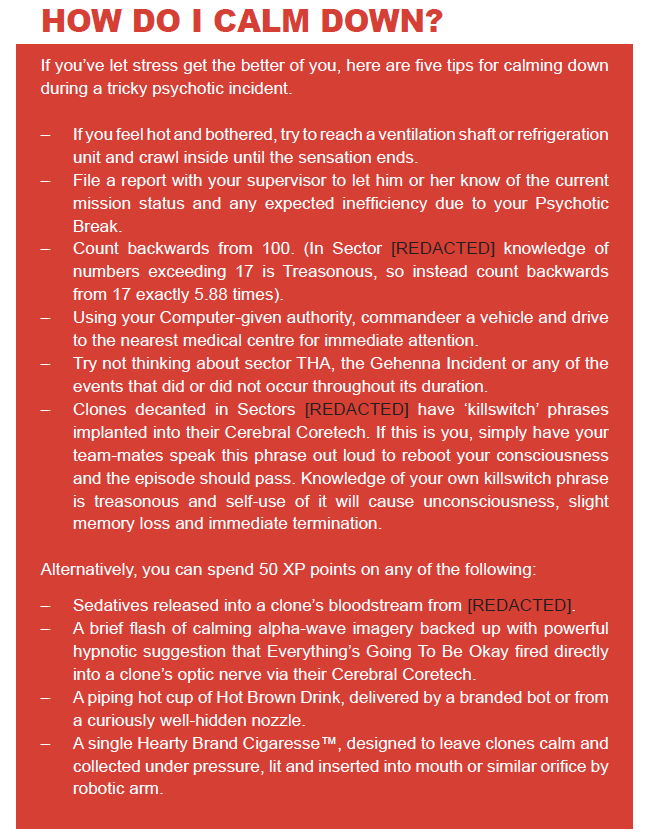
So, what happens when you run out of Moxie? Wellllllll.
Losing It
Zero Moxie means that the Troubleshooter is no longer keeping things together and is in the grips of a breakdown. This will generally lead to the Troubleshooter A: disassociating between their body and their actions, B: engaging in poor impulse control, C: feeling euphoric and motivated to do something specific, D: feeling unbridled generic/focused rage or E: all or some of these. This manifests as either the GM telling the player what their Troubleshooter is currently doing to act out/misbehave/shut down in some way or the player taking one of the descriptive adjectives and turning one/some/all of them up to 11 for Wacky Hijinks. If the player doesn’t play ball, the GM is encouraged to sidle them with some other undesired activity.
What’s important is that zero Moxie/Losing It does not stop unless stopped and the player is told to just fucking lean into the madness and run full-tilt into trouble to make it fun. The two surefire ways to stop a clone who is currently Losing It is to either A: subdue them in some form and hit them with a sedative, B: download more Moxie into your brain mid-freak out or C: simply kill them. The game doesn’t describe how a sedative works but let’s just go out on a limb and say that it’s the same as an administered stimulant where extra successes restore Moxie. Killing them is faster and the next clone comes back with 1d6+1 Moxie that can’t exceed their maximum Moxie.
COMBAT
The most important part of combat is that there are now Action Cards and the player will generally have four at their disposal at a given moment, give or take. You can only play one at a time (on your action or someone else’s) and you flip it over when you want to use it. Each card has an Action Order (the time in which the card can be used), level (only found on equipment, adds dice to your NODE) and a description telling you what the card does. Cards are vital to the flow of action and the new initiative system which the game calls DYNAMO, which stands for…
[sighs] Dynamic Yet Narrative Action Melee Order. Sure.
DYNAMO
Actions under DYNAMO function as either a Basic Action or a Card Action. Basic is just a Stat+Skill action while a Card Action is exactly what it sounds like.
- If you want to take an action this round, you have to place a card face-down in front of you.
- The GM counts backwards from 10 to 0 where each number is a moment in the Action Order. Act on your number.
- Hijinks ensue, the meaning of which will be explained in a minute.
- Actions get resolved, next round begins.
- You can either act on your number or act on a number through a bluff.
- You can bluff and go on whatever number you want to shoot first or whatever.
- You can call someone’s bluff once a round. The person attempting to act will then flip their card.
- If you are wrongfully challenged and successfully defend, the challenger must discard a card from their hand.
- If you were bluffing and got caught, you must discard your exposed card and can only take a Basic Action at the end of the round. The challenger gets two free turns this round: when they would normally take an action and the moment they complete their challenge.
- Once resolved, the people acting during that Action Order number roll dice and such.
- If there’s a tie between people going legitimately on the same number, the first person to say the full name of the other player’s character goes first. If all flub, nobody gets to act this round.
- This never applies to NPCs, NPCs just go when the GM says they do.
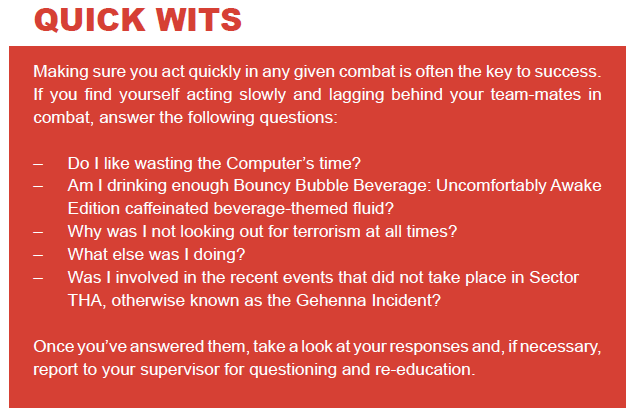
We have already established that Reboot is all about fostering a negative atmosphere. Continuing to enforce this through card bluffing to keep the agitation and abrasion fresh is an awful idea. Then there’s the fact that you do not have to use your Action Card. You can choose to flip your card and play it, you can choose to return your card to your hand and take a Basic Action or if the card says Action on the back you can discard the card and take a Basic Action with +1 dice to your NODE. Again, you do not need to play your card at all, you only must have a card at all to play to engage in any sort of combat. Out of cards? Tough luck! You also must burn cards to defend in melee if the enemy attack connects. You can’t defend at a distance and you can’t defend without sacrificing a card.
How do you get more cards? Depends on the GM. They recommend either drawing 4 cards at the start of combat and discarding them when done to use them in fights only, or to draw back to the full number when done. It’s up to the GM if the cards can have effects on the world outside of combat.
- Action Cards are narrative to some extent and grant dice bonuses depending on how descriptive you are.
- Reaction Cards do not have an Action Order number and are, well, reactions. They can be played A: before a roll if they modify the NODE’s pool, B: after the dice are rolled if they modify an outcome or C: after the GM/player doing a thing has described their action but before someone else does something if it’s some other Reaction. Reaction Cards can be played even if you’re dead or somewhere else.
- Equipment Cards function like Action Cards except their number is dependent on Equipment Level+Relevent Stat. Burning the card for a dice bonus to your NODE means the equipment is destroyed and we all know that destroying mission-critical equipment is treasonous.
- Mutant Powers require an expenditure of at least point of Moxie but you can pay more Moxie for a bigger effect and more dice to add to your NODE. When flipped, the only person who gets to see the Mutant Power on the other side is the GM and you never discard your Mutant Power if caught in a bluff.
Simple Combat Order
- The person to the left of the GM states their action this round and resolve their actions. This continues around the table until everyone has acted.
- NPCs act whenever the GM says they do.
- When the round is complete, the next round starts with the player to the right of the GM.
- That’s it. Please don’t hate us. Please like our game.
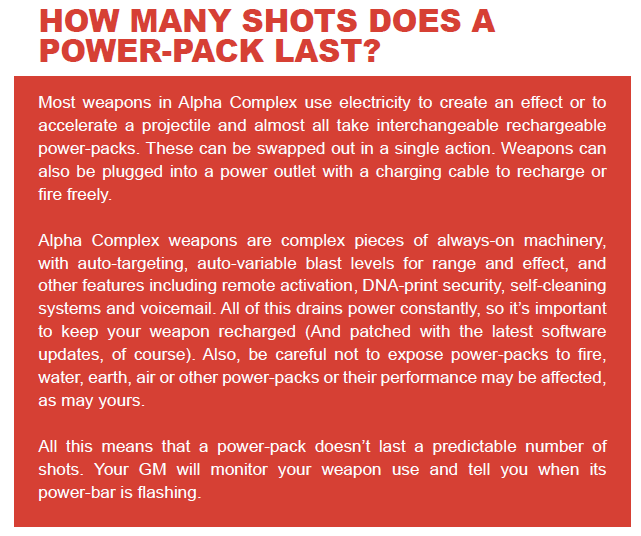
OTHER MECHANICAL COMBAT STUFF
Damage
Damage depends on successes that exceed the target number to hit someone. Technically speaking I think if you match the target number exactly that means you don’t do damage which is something I’d rectify to become “a tie is a minimum of one damage”. Damage is measured in cumulative levels in a simplification of XP’s damage system that I do agree with: Unharmed, Hurt, Injured, Maimed and Dead.
- Unharmed is the natural order of things for your clone: generally physically okay, mild neuroses.
- Hurt reduces all NODES by 1 due to general discomfort.
- Injured means that there’s enough pain to substantially mess with your clone’s problem-solving skills, reducing NODE by 2,
- Maimed means the clone is banged up enough to lose function of a part of their body (finger, limb, ear, cardiovascular system). You need immediate medical attention, resulting in a -3 to NODE. For every round you go without attention, roll a dice and die on a 1.
Fixing damage requires a First Aid Kit and a Brains+Science check. Each success lowers the clone's current state of damage, but missing a limb will generally require a specialized medical kit that has regeneration chemicals. Death is generally followed by having a freshly vat-grown clone delivered ASAP via some kind of method appropriate to the moment. Clones are once again considered to be a separate person from the last Troubleshooter in cases of treason and will keep the XP, memberships, powers and memories of their last life. You also get your gun and clothes back but make sure you pick up your old stuff because that won't necessarily be replaced.
THOUGHTS
Man do I dislike DYNAMO. All previous criticisms of their waffling apply. I will admit to being so put-off the first go around at how bad character creation was, I didn't even bother to try to figure out how the card system worked and snottily derided it as useless. Well, I will admit to being wrongfully judgmental in the moment. It's not the best card system but it's not the worst and the initiative system is the bad part of it. And honestly, despite admitting that the damage system has now taken a turn for the better, I'm not super wowed by these mechanics. They're generic, they're serviceable, they're forgettable except for the twists and I don't feel there are enough twists to spice it up. We'll get into the cards proper in a while so hold your questions and criticisms until the proper time. For now, just shake your head at the idea that non-successes should eat successes and how probability is a cruel mistress.
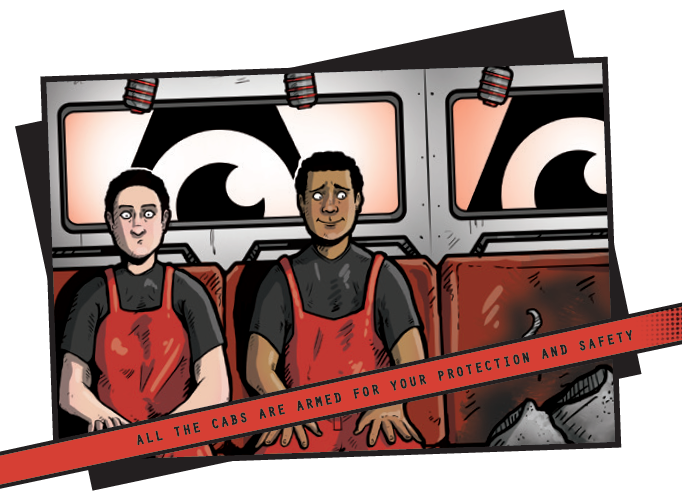
NEXT TIME: the end of the player's guide. What's in the end of the player's guide? Mostly equipment and stuff such as how your brain software works and how XP functions.
ODDS AND ENDS
Original SA post
ODDS AND ENDS
Or
XP=Currency to A Logical Extreme
Cerebral Coretech
Thanks to advances in Alpha Complex technology and the fact that smart phones are a well-established way of life in the real world, PDCs are out and CC is in. What this basically amounts to is “your brain is a computer and you can message the GM via text or IM to speak with Friend Computer”. Friend Computer can speak right into your brain and you’re able to speak back with sub-vocalizations. Your eyes also function as cameras, letting you record directly to your grey matter if you let the GM know you want to. Cerebral Coretech also gives clones direct access to ordering catalogues, news updates, instant messaging, Alphapedia (translation: information in the player’s guide) and treason alerts. In lieu of the classic “security cameras are everywhere” atmosphere of past editions, everyone in Alpha Complex is always extremely online and doing all the surveillance Friend Computer needs.
Except for those pesky dead zones. When you’re connected to the wireless network, a clone can see people’s names, XP total and treason stars floating over their head. Step into a dead zone and that goes away, working as a good indicator of where you’re no longer online. Things you’ve already downloaded to your brain will remain, but dead zones cut off the ability to order supplies, speak to the Computer or update their software. Most importantly: MemTech memory backup ceases functioning in a dead zone, cutting off immediately once one steps inside. Die in there and that knowledge is lost. There are enough dead zones that reporting them to Friend Computer nets a pretty good XP bonus.
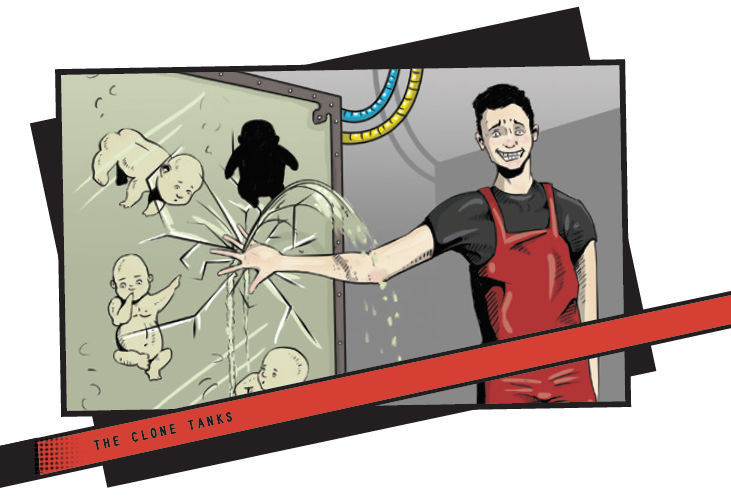
Speaking of gamifying work instead of paying people a living wage because capitalism is a hellscape!
XP
XP is earned through working hard, through completing missions or through achievements (this came out before the Cyberpapacy revamp, I believe). Every clone earns 1 XP a day plus bonuses for good behavior in service of Alpha Complex. When you consider that Red clearance costs 500 XP and XP is also money, there’s only two ways to escape drudgery and toil before you die six times: missions or achievements
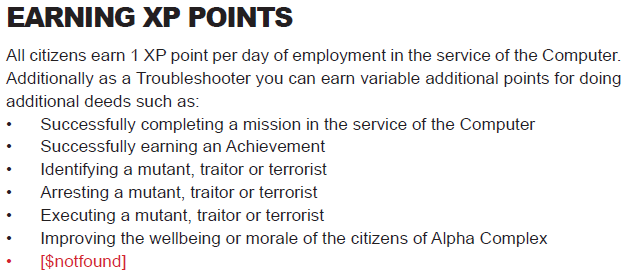
Mission XP is a big ol’ pool that gets dumped on the players by Friend Computer and is then divided out fairly (your experience may vary) by the Team Leader. The pool can be reduced by property damage, breaking/losing/misusing equipment, dying and having your clone delivered or the weather. Achievements are optional bonus objectives that can only be redeemed by one person per mission, not one group per mission. Feeling salty about having a character you don’t want and other players keep challenging your cards in combat? Let’s up the anxiety and discomfort by adding first-come-first-serve XP bonuses into a volatile environment! Every mission has its own bonus objective cheevos but these are some sample cheevos.
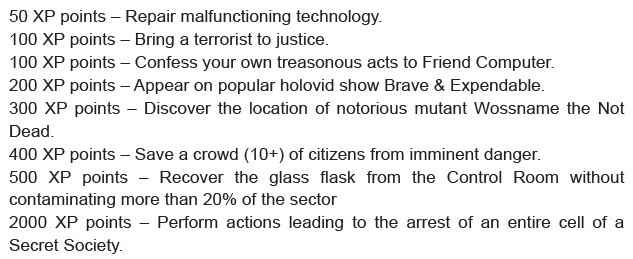
XP can be spent at any time by just focusing very hard on ordering things through your brain. Need more guns or grenades or pudding? Simply fork over the XP and it’ll be assembled and shipped to you ASAP. XP can also be exchanged to activate hormonal portions of the clone’s brain to make the body produce materials to enhance their skills, abilities or mental health. We’ve already mentioned that Moxie can be recovered for 50 XP a dot, but you can also permanently buy new Moxie slots if you burned them in chargen for 200 XP a slot (up to 8 max). Boosting a stat is 500 XP up to 3, skills are 200 XP up to +5 and specialist skills can be learned at 300 XP apiece.
Of course, there are other ways to learn skills. Sometimes you’ll get a skill software package downloaded as part of a mission for “temporary use” only. You can also do favors for folks in secret societies and reap the rewards in the form of being taught skills. Thanks to XP being a nontransferable currency outside of paying into catalogues, some societies repay members with education or their own currency.
The other big use of XP is to buy new clearances. New clearances can be achieved by sticking it out and working hard or you can just kill a bunch of terrorists and fast-track yourself. New clearances can be purchased at any time and resources inherent to your station (new gun, new uniform) will be delivered ASAP in a burst of confetti.
In a touch I mildly enjoy, you can also request cake for the moment if you pay a bit extra.
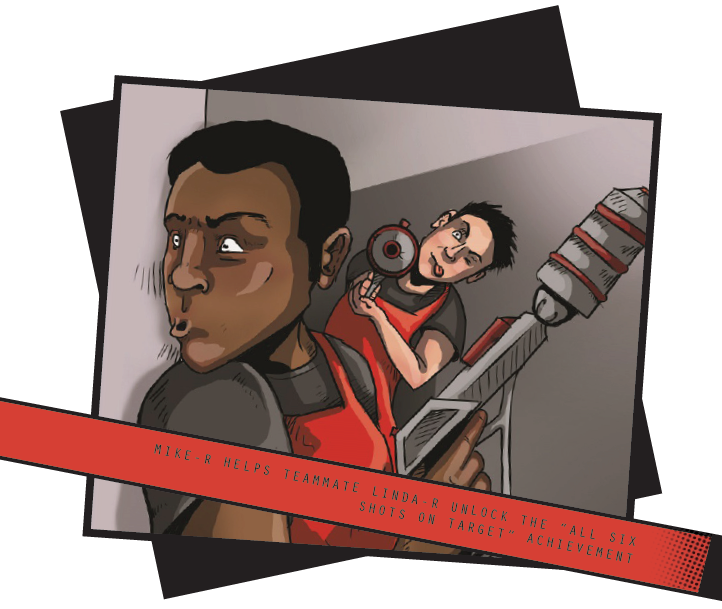
Secret Societies
This section is regrettably brief in this book. Most clones are recruited and don’t have to go looking for a secret society because pretty much everyone is desperate for help. Alternately make your own with the help of friends. Payment for helping further their goals is generally in in-house currency, equipment or knowledge. Thanks to the chaotic nature of Alpha Complex, you are most likely working with a splinter cell localized in a sector and you might not be able to lean on the help of your society in other sectors.
Equipment
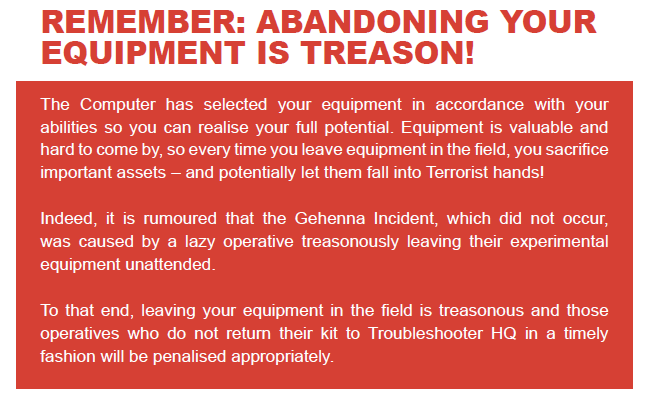
You always have a jumpsuit and a laser gun. Equipment adds bonuses to your NODE depending on the level of the equipment. You want that Orange laser pistol more than a Red for a +1 bonus if you’re using it in an appropriate way. For example: wedging the barrel of the gun between door handles to jam it probably won’t give that bonus.
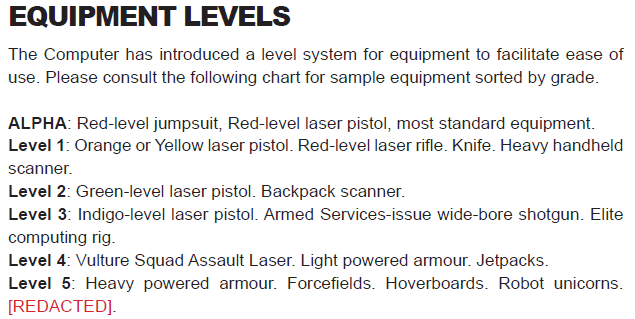
Equipment has a weight as well: Small, Medium, Large or Oversize. Small items (grenades, laser pistols, chips) are negligibly sized and only really tracked if you’re trying to carry an unreasonable amount of stuff. Medium items are held in one/both hands and require an equipment strap or a backpack, limiting you to two on your body (both on your body, one in-hand and on your back). Large items need both hands and a special carrying case. They’re big enough you only get one before encumbrance is an issue. Oversized items basically need multiple people to carry and operate and take up your attention and strength as long as you’re lugging them around. Oversized items subtract 2 from all NODEs and juggling 3+ Medium/2+ Large items inflicts a -1 penalty.
You may also be worried that you’re not starting with armor. Fortunately, your jumpsuits behave the same as Reflec does in other editions (which is to say it protects against lasers of that color or lower perfectly). Other forms of armor have armor ratings which mean they can take that much damage before falling to pieces. Finally, you can break equipment by attacking it and dealing successes equal to its size (1 for small, 4 for oversized, etc.)
Let’s wrap this whole thing up by looking at what one can purchase with their fabulous cheevo-earned XP.
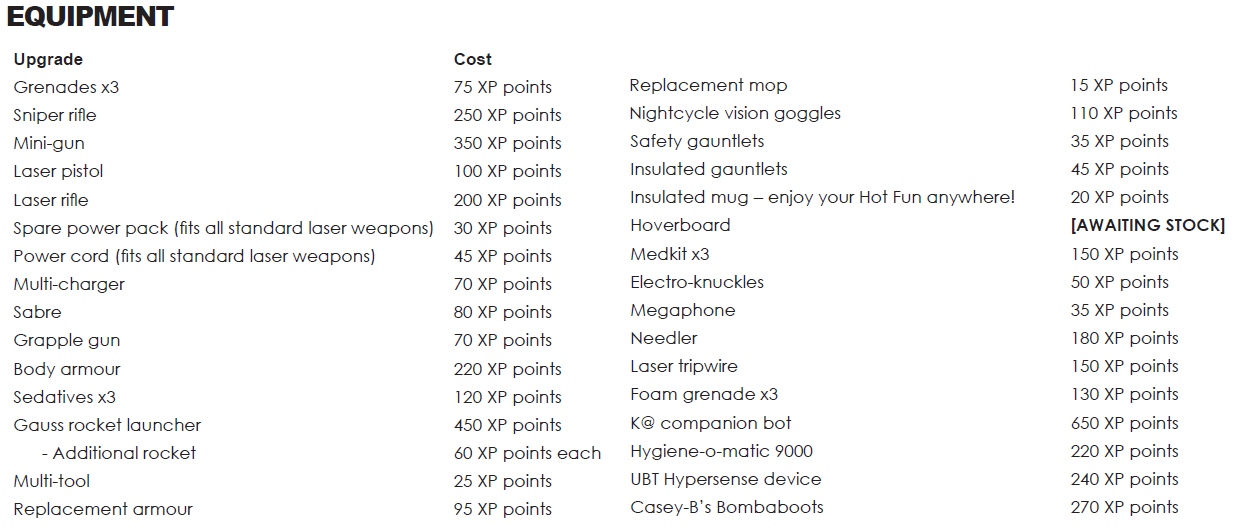
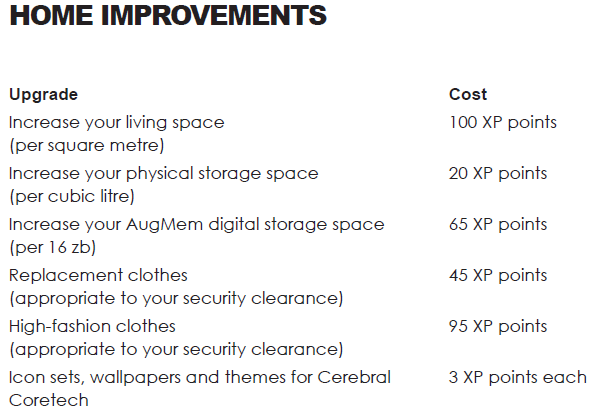
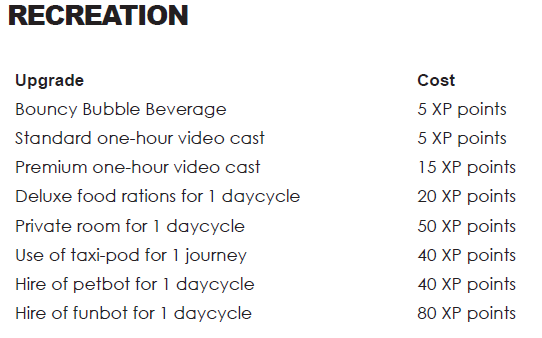

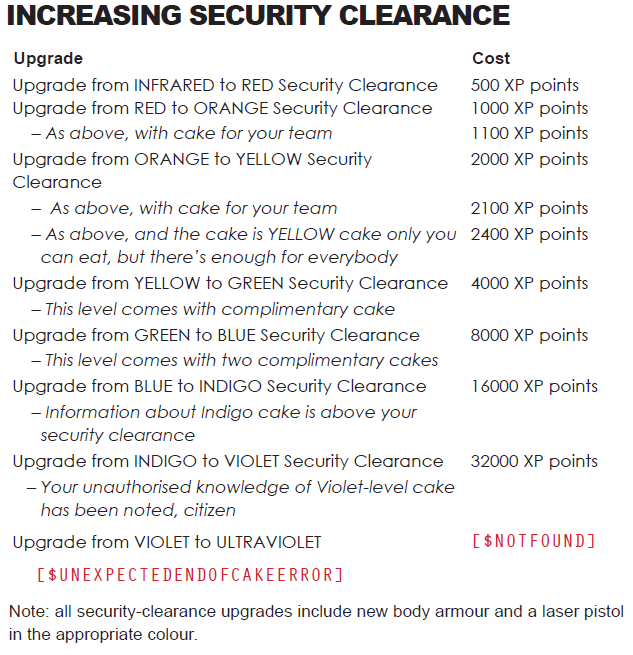
Thoughts
I’m not a fan of the fact that equipment is pretty much limited to things one can find on a card. I like the always-online nature of a clone’s brain. It goes into the good parts of Eclipse Phase territory. Outside of that, it seems to be trying to have its cake and eat it too regarding spendable XP. It’s an intentionally obtuse and Friend Computer-designed system that has subtext of “a ton of people hate this” lining the writing. They are right to hate this because even if you make it work, it’s a bad system. I know you’re not “supposed to” go far with the same character in Paranoia and the optimal course of action is to just keep buying bouquets of grenades (or 15 highly shaken cans of Bouncy Bubble Beverage for the price of three grenades but tomato potato). It’s still putting a bad system that some people would (reasonably) want to interface with inside an unfitting environment.
But hey, we’re officially done with the Player’s Handbook. Woo and also yay. What next? CARDS! Cards for everything, cards for days! I HOPE Y’ALL LIKE IMPROV!
GAMEPLAY CARDS
Original SA post
GAMEPLAY CARDS
Alright so with all those boring player’s guide rules out of the way, it’s time for cards! And boy howdy it’s not great. I’m not a gigantic fan of cards in tabletop. Gamma World 7e is kinda the highlight of card/game integration and even then, it’s tolerable because WOTC gave up trying with that and the card lists exist everywhere. The upside of Paranoia Rebooted is that it’s not trying to do a booster thing outside of more Mutant Power cards and more Secret Society cards. The downside is that everything else is kinda mehhhhhhhhh. 90% of the equipment from the equipment section exists in card form and Paranoia shenanigans that your players might be thinking about doing require cards. It’s weird and bad and lame to limit stuff and creativity as much as they do.
This is just gonna be all one post by the way because it’s 40 pages of cards with 3 cards to a page. 120ish cards. Hooray. Strap in and don’t go looking for art because all the art is attached to cards and I really can’t be bothered to post these cards and all of their bad art.
ACTION CARDS
- A Gun in the Right Place: Suggest a random useful ranged weapon that you can find. The GM can veto your suggestion. +1 dice to your NODE if it’s useful/functional. If you come up with something super creative, +2 for the first action and then +1. Kinda hope you all are in the mood for some GM May I freeform improv ‘cuz welcome to the cards.
- Adaptive Resources: As above but a melee weapon.
- An Unexpected Boon: Play after target has rolled but GM has described outcome. Adds +1 to target’s result if you narrate something useful. GM can veto.
- Called Shot to the Groin: Roll 1d6. If you shoot an NPC, they’re incapacitated for that many rounds or half if they’re a PC.
- Collateral Damage: Played in direct response to someone’s action, that action then breaks something. GM can veto the suggestion.
- Colossal SNAFU: To quote, “GM, pull out the thumbscrews.”
- Combined Assault: Pick another player to either attack the same target as you with +1 to hit or attack you with a +1, their choice. Does not count as their turn.
- Critical Failure: Now in card form because they wanted players to be able to choose when this happened and they couldn’t bother to figure out how this would work in a Pile O’ D6s system!
- Critical Success: See above!
- Drop It: Played before the GM resolves a target’s action. Target fumbles and drops one piece of equipment, GM can veto/ignore suggestion.
- Easy Come, Easy Go: Immediately neutralize any card played on the table and force it to go to the bottom of the deck it came from.
- Everything Looks Like a Nail: Like Adaptive Resource/Gun in the Right Place but for tools.
- Feint: Describe a situation that will help you bamboozle a foe and roll Chutzpah+Bluff if the GM likes your idea. If you succeed, describe what the enemy does.
- Flesh Wound: Play on a target just as someone/you are about to attack someone. This causes the attack to make the target lose a limb. I guess it’s just a free damage upgrade to Maimed? Kinda nice.
- Four’s a Crowd: Create a group of NPCs who are either helpful or hindering to the moment, GM can veto suggestion and controls them after the next around.
- Function Over Form: Adaptive Resource/Gun/Nail but with terrain features.
- Great Victory: Get what you wanted for a few seconds, GM describes how.
- I’m Going First: Cut in the initiative line.
- I’m Thinking: Draw three cards, pick one, pass another to another player, put the third at the bottom of the deck.
- I’ve Got A Plan: Improvise!: Declare an action before you roll, draw an Action Card and mash ‘em together.
- Improvised Defenses: oh for fuck’s sake like those other four cards that give you +1/+2-+1 but with armor.
- Jam: Target’s weapon jams or their gun still works but now jam is involved in the moment somehow. Jam as in spreadable sugary fruit preserves. It is a punne, or a play on words.
- Ka-Boom!: Add an explosive thing to the scene that has a three-meter blast radius that the GM can veto.
- Keep Your Head Down: Hide behind/in/under something and automatically dodge all attacks for a round at the cost of not being able to do anything else.
- Lucky Manual: A piece of equipment is destroyed to negate damage you would take.
- Man, Am I Pleased To See You: like all those other improv things but this is a dude you know who can choose to help or hinder.
- Miss Identified: see above but a lady. please make the hurting stop.
- Mistaken Identity: Foist the blame for your actions on someone else, GM can veto suggestion.
- My Lucky Vent: IMPROV BUT FURTHER USEFUL TERRAIN FEATURES GOD DAMN IT
- Not So Hot: Remove a target’s success due to hindrance.
- Opposite Day: Play in response to someone’s actions so the exact opposite of what they want happens.
- Party Trick: Convince the GM that a nonstandard Stat+Skill combo is applicable to this moment. If they agree, +2 successes. If not, -1 successes to the attempt.
- Risky Trick: Make an action dangerous. +2 dice to any action but take 1 level of harm per 1 rolled on dice. There are two of these cards.
- Safety First: SAFETY EQUIPMENT. USEFUL. IMPROV. IMPROV! IMPROV!
- Should Have Killed You: Lose a point of Moxie to negate all damage from an attack because it missed you but it was too close.
- Slightly Worse Than Expected: Not So Hot but renamed and applies to everyone, not just enemies.
- Snap Decision: Go first but at the cost of 1 dice in your NODE. There are two of these cards and if played at the same time they negate and neither player goes at all this round.
- Sneak Attack: +2 to an attack NODE but swap Violence for Chutzpah, Stealth for Melee or both.
- Sudden Death: Upgrade any damage done by an attack to be immediately lethal to the recipient. GM can veto description.
- Suddenly, Knives!: hand-to-hand improv weapon spiderman elsa pregnant clone stabbing happy happy treason
- Surprise Bot: improv robot hinder help bonus call the police I’m dying
- Tactical Assessment: Brains+Skill roll to make a useful plan. If you succeed everyone acting on your advice gets +1 dice or -1 if you fail.
- Take Your Time: Go last in the round but get +2 dice. There are two of these cards but resolve at the same time if used together.
- Taxi: improv vehicle.
- Up High: improv elevated terrain.
- The Wetter The Better: improv helpful/hindering liquid. probably piss. piss all the way down. pisssssssssssss.
- Wrong Target: Convince the GM to let an attack hit someone else the attacker didn’t intend to hit.
- Blank Card: Make your own cards. Now it’s you who needs to improv. Fucking mindfreaked.
- Grenades: Comes with 3 grenades. Has a five second timer, “you could probably” set them to a fuse or detonator. Small equipment.
- Minigun: Has 1d6 ammo rolled by the GM. You don’t know how many shots it has unless you disassemble it. Large equipment.
- Sniper Rifle: If you take the time to calibrate and aim with it, bonus dice. If you try to hip-fire this thing, penalty dice. Medium equipment.
- Multi-adaptor: Recharges a lot of things from a single power outlet. No real mechanical use from what I can see. Small.
- Gauss Rocket Launcher: Either launches explosives via electromagnetic propulsion or fires gauss rockets. Either way, three charges, large.
- Grapple Gun: Can be used as a weapon that will then attach you to your target. Medium.
- Body Armor: +2 Defense but it’s noisy, really finnicky to keep on and prone to running out of power at inopportune times. Large.
- Medkit: Heals real good-like, has three charges. Full of delicious painkillers and regeneration nanomachines. Small.
- Electro-Knuckles: Brass knuckles with a battery attached good for four charges. Small.
- Sedatives: Great for stopping panic attacks. Three charges. Small.
- Data Bomb: Basically a chaff grenade mixed with an EMP. Turns off all electronic activity in an area for 1-3 minutes and makes tech easier to tamper with. One use only. Medium.
- Taxi Pod: Basically a golf cart with an electric motor that can carry 4 lightly equipped clones or one heavily armed clone. Oversize.
- Megaphone: Great for screaming. Medium.
- Needler: A handgun that shoots darts up to 15 meters. Normally carries tranquilizers that take hold in a few minutes but you can request special darts. Medium.
- Friction Enhancer: A gun attached to a heavy backpack that either increases or decreases friction by 500% in a 30 degree beam that ranges up to 15 meters…as long as the trigger is pressed. Backpack weighs 65 kilograms and drains in 20 seconds. Either buy a new battery or wait 8 hours for it to recharge off a plug. Large.
- Laser Tripwire: Emits invisible laser beam from a brick-sized box that can attach to most surfaces. Laser beam projects up to 10 meters and things that break the beam are cut in half. The on/off switch only applies to it being stuck to surfaces, the only other controls are for clearance access or bots/no bots. Explodes if tampered with. Medium.
- Foam Grenade: Comes in packs of three. Each explosion makes 30 cubic meters of expanding foam that solidify in 2 rounds and trap anything inside. You can escape the foam before it hardens but once it’s firm there’s no escape short of death/amputation/dissolving fluid that also likes to melt skin. Anyone completely covered will suffocate to death in a few minutes. Small.
- K@ Companion Bot: ROBOKITTY. Robokitty has a 12 hour battery life, night-vision and titanium claws/teeth and acts as a remote sentry/surveillance unit. If robokitty’s whiskers are damaged, it goes feral on a failed Mechanics+Operate roll and must be recaptured. Also has a penchant for attacking other robokitties and lasers. Medium.
- Hygiene-O-Matic 9000: Basically a flamethrower and mounted pack but with five canisters of cleaning products. You can choose a setting but on a failure the GM gets to pick which product is used and used up completely instead. Contains a combination of soap/shampoo/mouthwash, industrial solvent/paint-stripper, pure bleach, flammable sanitation gel and finally quick-dry superglue. Large.
- UBT Hypersense Device: A full-head hat-mask thing with diodes and cups attached used to enhance one sense at the cost of any of the others…if used properly. Side effects include synesthesia and disorientation. Small.
- Casey-B’s Bombaboots: Essentially rocket-jumping boots sans rocket that are controlled via Cerebral Coretech. Boots have four charges of superheated mercury vapor in soles that grant user 7-meter vertical leap or 10-meter horizontal leap. Failure tends to result in user losing legs, also bad idea to stand within 2 meters of user. Even if used correctly, horrendously messy scuff-marks/scorch-marks. Medium.
- Fake Mustache: As advertised. Attaches via nasal clamps, causes all Cerebral Coretechs/bots to view user as John-R-DOE-1 or any other name programmed. Will not work with Friend Computer. Small.
- Blank Card: Yeah, here too. How do you balance and design equipment? Fuck off.
Reminder: pay Moxie to activate, pay more Moxie to power more gooder harder better faster stronger for yesser effects.
- Telepathy: Either read a dominant thought or implant a simple suggestion.
- Anomaly: Something happens. Does this mean the GM must improv? YES. YES IT DOES.
- Corrode: Destroy a Small item you’re touching within the next 30 seconds. Requires more power to affect things bigger than Small or that you’re not actively touching.
- Cryokinesis: Either lower the temperature within a line of sight or creates a small patch of ice where you want it. Requires more power to hurt people/freeze them in blocks of ice.
- Electroshock: Zap with a touch. Requires more oomph to zap at a range.
- Invisibility: Turn yourself and all of your equipment invisible. Only lasts for a few seconds and is hard to use in bright light without expending more mojo. Regardless of how much mojo you spend, you can’t turn others invisible.
- Levitation: Baseline levitation is a meter off the ground at a walking pace. Spend more Moxie to go faster or rise. It’s also good for slowing falls or stopping them entirely.
- Machine Empathy: Pay more Moxie for it to work better for longer than a scene or affect more bots. Explicitly does not work on the Computer slash you are not allowed to use it on Friend Computer.
- Mental Blast: Cause a point-blank AoE blast of nosebleeds and headaches. Can be amped up to cause blackouts, injury, seizures and death.
- Puppeteer: Control a single limb of another within line of sight. Requires more power to be spent to control multiple limbs or perform precise actions.
- Pyrokinesis: Cause flames to happen near you. Requires more effort to set them at a distance or set big fires or set a moving target on fire.
- Strength: Basically the old standby of Adrenal Control without the crash and muscle fatigue. Run faster, jump higher, hit harder, pay more Moxie to really amp up the gains.
- Telekinesis: Push or pull one Small item with your mind. Requires more focus to either move bigger items or make precise movements like pulling the trigger of a gun.
- Teleport: Uh. Teleport. Requires a greater expenditure of thesaurus words to bring people with you or go further. Cannot be used to teleport things by themselves; you must go with them.
- Adhesive: Sweat glue, stick things to other things or yourself to things. Up the output of requiring an expenditure of Moxie to make more glue or make it last longer.
- Charm: Basic use targets one other clone for a scene, can target more with a harder push of power.
- Blank Card: Yep.
What remains? Well as previously mentioned, Secret Societies are drawn at random from a deck of them. We’ll be going over them later. The only particularly relevant thing to mention is that there are two cards that amount to “no Secret Society”. The first is that you have no Secret Society and you’re on the hunt for them to get that sweet achievement XP. The other is that you have no Secret Society but you really would like to join one and should bug the other players to let you join by assisting them in their own tasks. The former is bad. The latter is better and is at least good for fostering the good kind of party friction.
There are also cards that outline the duties of team members, which are a little bit different than usual because of the replacement of the Communications and Recording Officer due to the fact that everyone now has a camera phone brain.
- Team Leader: Ensure mission directives, give directions, make sure everyone else is doing their job, be the scapegoat due to the mantle of being team leader.
- Loyalty Officer: Ensure loyalty, report disloyalty,
execute traitors, suffer not a witch to livefoster an environment of fear of you.
- Combat Officer: Give commands in combat, provide tactics and maneuvers, fight from the rear.
- Happiness Officer: Ensure happiness, dispense drugs, request drugs, make sure that therapy flows from the barrel of your gun.
- Science Officer: Ensure science is done properly, make sure everyone is clean, be rational, use acid as a solution to messes and science being done wrong.
- Equipment Officer: Hand out equipment, carry equipment, maintain equipment, tamper with equipment.
There is also one last card I will actually provide the art for it.
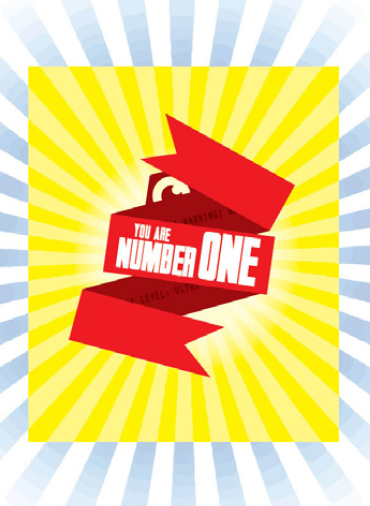
This is the #1 Card. What does it do? Who knows! Okay I do know. Its true purpose is sinister.
Alright fine it’s just a means to foster more resentment and friction at the table.
NEXT TIME: the GM Handbook. Hooray. Y’all ready for more lacking rules and weird ideas and setting information? What do you mean no. Where are you going. Don’t leave me here alone with this book!
THE GAMEMASTER’S HANDBOOK PART ONE
Original SA post
THE GAMEMASTER’S HANDBOOK PART ONE
Or
The Spiritual Successor to Y’all Rambling About Warhammer Right About Now Because Shit’s Fucked Elsewhere
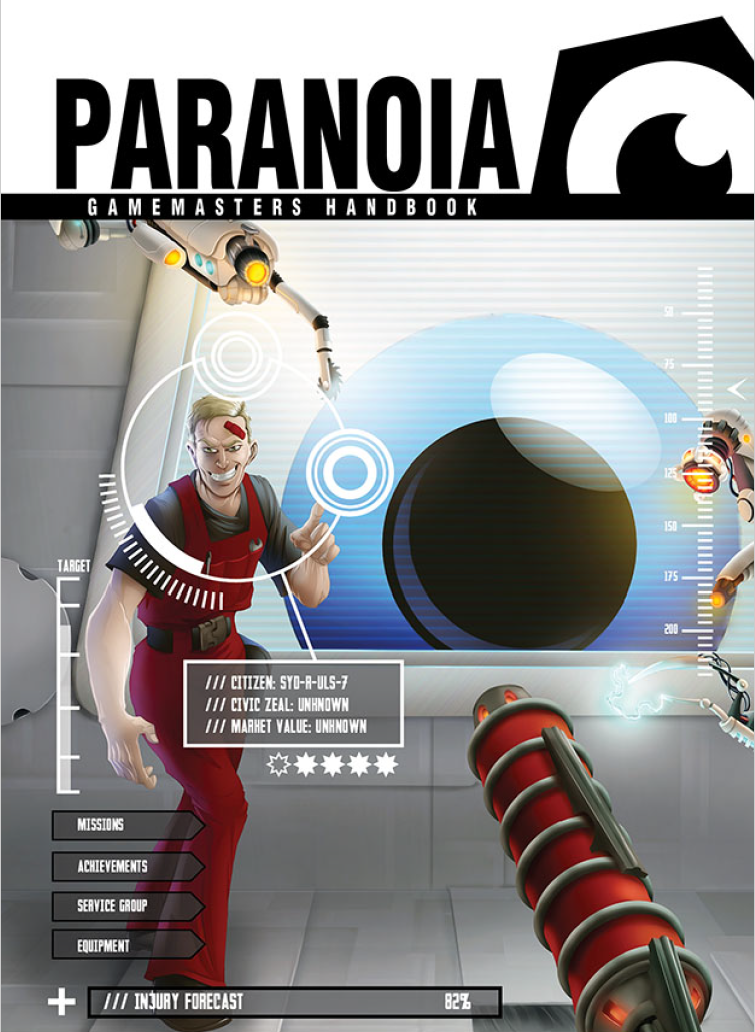
To keep in theme with past Paranoia products, this is also Ultraviolet material and outside of the players’ pay grades. It’s broken into a whole mess of sections without much rhyme or reason to it and the beginning introduction explains what’s really going on in Alpha Complex.
The Truth and the Lie
A lot of information in the player’s handbook is a misdirection at best or a falsehood at worst. It paints the world as being like a past Paranoia product, one where things are dysfunctional but, well, functional. It’s easy to read the setting as being like XP with a happy smile painted on the boot stamping the face forever. That’s not true. For reasons unbeknownst to me, the writers of this game have decided to take Alpha Complex in a weird new direction.
The nice way to put it is that Alpha Complex has been in freefall for centuries and has finally now reached the point where it’s gonna hit the ground. The less nice way to phrase it is that Alpha Complex’s woes are an unrecognized cancer that is far more malignant and terminal than anyone recognizes. You are advised to ignore the ideas they’re putting forth from here on but they have admitted that they think the product needs a new coat of paint to entertain and enthrall players. Grain of salt with that advice.
Alpha Complex has been functioning for centuries more than anyone expected it would ever need to. It was put online to help people avoid a long-gone (or IS IT?!) threat Outside and there was the hope that eventually people would reclaim the world. Well, best laid plans and all that. Alpha Complex keeps going and it’s still the year 214. The sheer weight of time, wear and tear and neglect have put a gigantic strain on the Complex and the Computer. The resources that run Alpha Complex are tapped. All the coding and tampering that have turned the Computer into a mess of cognitive dissonance has reached a critical peak. Paperwork has reached a bureaucracy where it is literally impossible to engage with important steps of most requisitions because there is no more paperwork to make the forms you need. Most damningly, there is no more innovation. Scientists are inventing in circles because old data gets lost or destroyed and the resources have flat run out. Alpha Complex is on life support, the prognosis is bleak, the cancer is inoperable and the brain running the body has dementia and not enough medication.
There is not enough anything. Food, water, power, robots, iron, rubber, springs, pens. This has lead Friend Computer to act in a much more straight-forward matter. Entire sectors are shut down and mothballed, the surviving clones relocated to a new sector. The recycling of everything continues. Above all else, the Computer’s mandate rules.
- “Terrorists” are causing everything wrong with Alpha Complex and should be rooted out and destroyed.
- Terrorists are made from treasonous thoughts and behaviors.
- Treason thoughts and behaviors happen when Friend Computer is not in control.
- But Friend Computer is absolutely 100% in control of Alpha Complex.
- But Friend Computer is not absolutely 100% in control of Alpha Complex.
- Friend Computer’s role is becoming increasingly irrelevant, the Complex is failing and there are no easy solutions for either problem.
- This must be because of Terrorists.
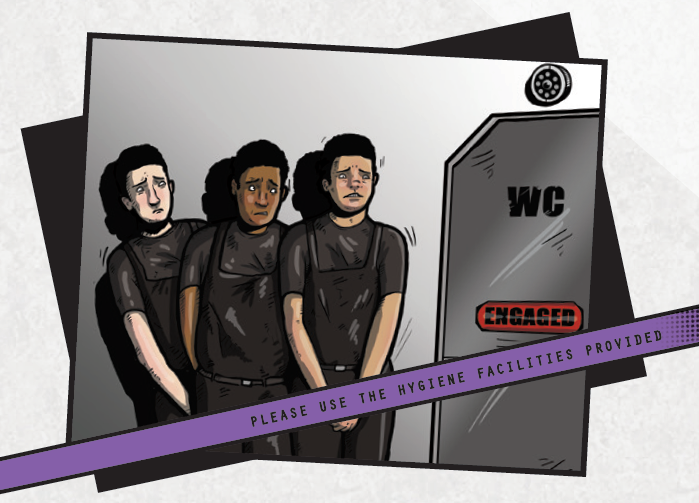
See, I’m no stranger to weird grimdark settings that are too dour for their own good. New Paranoia recognizes that everything I said above is dumb and bad and stupid. You want to take the oppression of a civilization on its last legs and wring it for jokes by removing all subtext and making it too stupid to be depressing. Sample suggestions:
- Sometimes vents will just suck in clones and they’ll never be seen again.
- A sector where all PA announcements are replaced with deafeningly loud sirens and nobody knows how to fix it.
- A sector where all of the food tastes like lutefisk.
And as we’ll see what they intend Alpha Complex when we look at the premade missions, it really does not work.
How To GM
Despite my generalized grumblings, this part of the book isn’t too bad and it’s pretty comprehensive. See the thing it doesn’t really spell out in the player’s guide (but does at least hint at) is that this new edition is focused less on GM interaction. Which is a really cheesy way of saying that there’s actually a point to all that goddamn improv. The threefold job of a GM, as they see it is, is to 1: describe the world, 2: control the NPCs and opposition and 3: act as the arbiter for the consequences of player action. Pretty simple stuff but it breaks down a little bit deeper.
First, “only describe what you feel is necessary”, namely one or two vivid details or four sentences of description max. This is so the players can get a handle on what’s important faster and also gives you wiggle room for when they want to add things to the scene through cards or questions. Second, let the players actually be the focus of everything. You don’t need to go bananas on the NPCs in the area, they don’t have to be telling them everything that needs to get done, don’t bog yourself down in minutiae. Third, err on the side of fun and be willing to let the players do dumb shit that might not be totally street legal but is definitely inventive. Everyone is at the table to have some fun and it’s fun for you to bounce off your players and turn a series of rolls and outcomes into a dialogue or unintended consequences. In my two cents you should also probably remove the improv cards but that’s me. I don’t have anything to really say about the advice so far, it’s solid and reasonable advice.
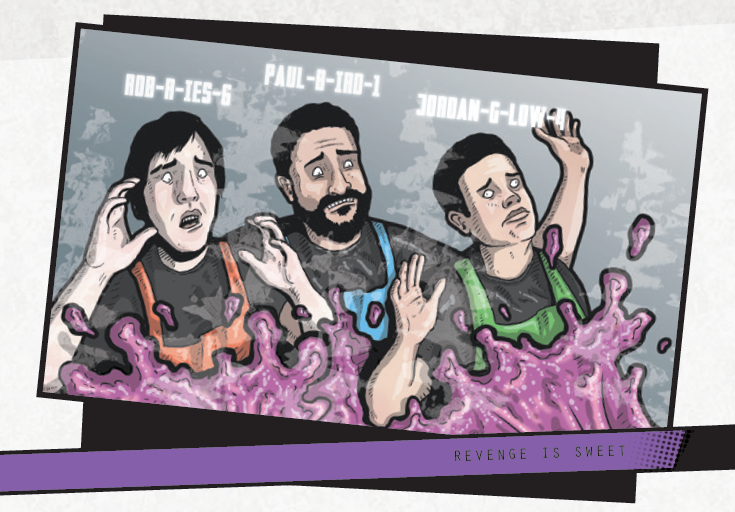
Also, solid and reasonable: the GM doesn’t roll dice if they don’t want to. They initially start off with “the GM never rolls dice!” but then waffle because “what if I want to roll dice [sniffle sniffle]?” is the follow-up to that.
quote:
“Listen; you’re the god of the game-world, for all intents and purposes, and God doesn’t play dice, so neither should you. You can put the effort in and stat up your NPCs as though you would a PC, and you can try to keep track of skills and bonuses and numbers and chances and options... well, honestly, it’s a lot of work and we’re against that.”
Play Example posted:
The Computer is still having problems with the security-clearance servers.
Three Troubleshooters – Rob-R-IES-6, Jordan-G-LOW-4 and Paul-B-IRD-1 – are entering the server room to investigate.
GM: You open the door. There’s a masked clone with a laser rifle standing right there, waiting for you. It opens fire.
Rob: Rob-R-IES-6 slams the door in their face.
Jordan: I’m playing this card (plays the ‘Jam’ action card)
Paul; I – that is, can my character Paul-B-IRD-1 make a dodge roll?
GM: No. Rob-R-IES-6, roll to slam the door.
Rob: Violence plus Operate gives a NODE of 5, I roll… two successes
GM: You slam the door really hard. The now-unseen figure still opens fire,
unless – Jordan, does their gun jam?
Jordan: No, it’s a jam gun. It fires jam.
GM: A stream of jam at ludicrously high pressure punches through the flimsy door
and hits Paul-B-IRD-1, slicing them in half like a laser made of strawberry jelly.
Always give the PCs a chance to react and avoid before you hurt or kill them. Rob-R-IES-6 and Jordan-G-LOW-4 reacted and did stuff, moving the scene along and were rewarded for it. Paul-B-IRD-1 didn’t react fast enough and suffered the penalty. That’s okay, that’s why PCs have more clones. Also, note there are no dodge rolls in Paranoia. Dodge rolls are a lazy player’s way to avoid thinking about what to do. Lazy players shift the storytelling and creativity onto you and you want players who engage and think dramatically along with a system of mechanics that supports that.
Not optional, however, is target numbers which are pretty self-explanatory and by self-explanatory, I mean I can fit it into one picture and move on with my life.
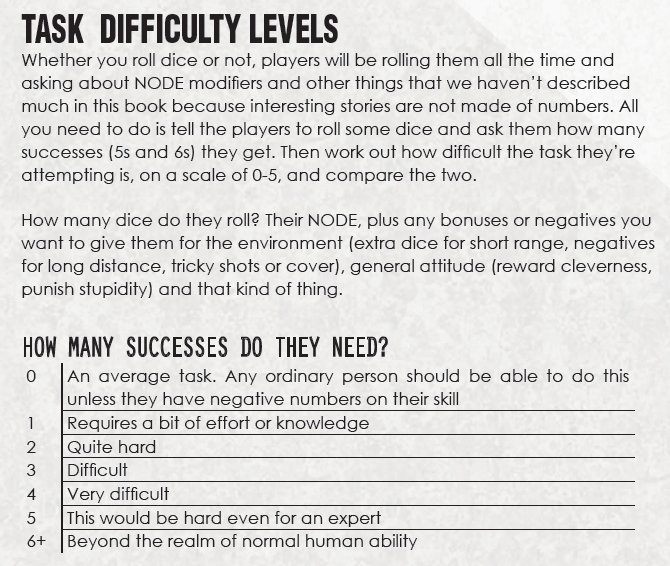
The Computer
The last thing we’re going to get to today is what it’s like to be the Computer. In short, you’re asked to compare your last smart phone that was two years old to when it was fresh out of the box. That’s pretty much what the Computer is like now and man I’m not gonna lie, that’s probably the best metaphor in this book. The Computer has zero clue that it’s an overstressed, slow-running piece of obsolete technology with a shitty battery life, a pretty worn SIM card and an inability to fully connect to the wifi. But, more importantly: Friend Computer is not cruel and not a bastard. It’s utilitarian and using everything it has to the best it can (best being relative for its state of mind). If the good of all humanity outweighs the good of one clone, it has no problem with telling a clone to go crawl through a radiation heat-purge vent. It can’t lie but it can choose to omit pertinent information. It doesn’t have a heart, just a whole lot of cruft and add-ons that make it look like it does. In another reasonable comparison, even talking to Friend Computer is a lot like talking to Siri or an automated system with better voice recognition. Now attach that to the Clippy interface and you’re not allowed to disable that function. That’s the Friend Computer of Paranoia Rebooted.
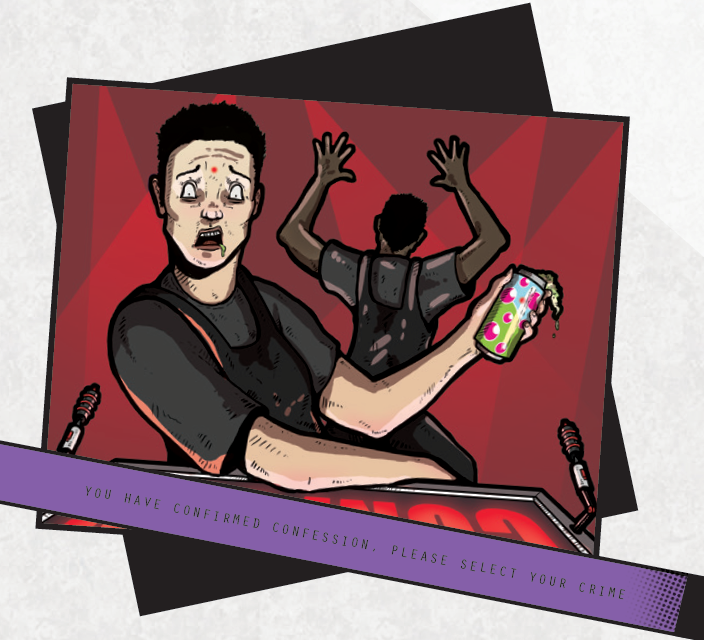
The most concrete thing they give to share is how exactly to do the whole “twist the knife/dig yourself deeper” thing that a lot of Paranoia wants you to do with Friend Computer but doesn’t. Friend Computer doesn’t understand lies but it does understand that people talking to it might not be telling the full story themselves. It can tell if you’re lying thanks to biometric data but it wants to trust in the goodness of humanity. What it does instead is that it takes your responses and tries to see if they jibe with its (broken) worldview and (twisted) operating parameters. This leads to a lot of questions where there is no correct answer and leads to Friend Computer essentially going down a built-in flowchart to get to a resolution as it probes you for more details (metaphorically speaking of course). In short, it really is a lot like an automated voice messaging machine trying to figure out what you’re saying and where to redirect your line based on your input. Except in this case there’s no operator to pick up, no manager to shunt your call to and it can’t just hang up.
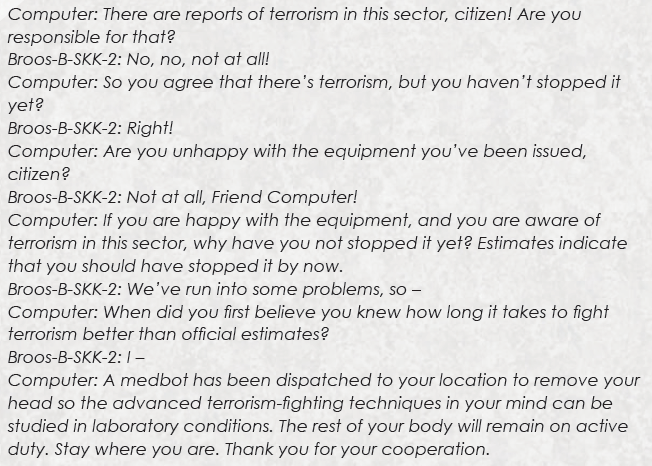
Though admittedly it does undercut its portrayal of Friend Computer by going back to the ol’ monkey cheese well. The game also advises to just add Treason Stars to players whenever you see fit based on their answers to questions with no good responses.
THOUGHTS
Alright there’s a few things I want to cover but I do want to say this: upon closer reading, it’s not as bad as I remember it being. There are some good pieces of advice but we’ll get to that.
New atmosphere: I hate it. I don’t mind taking it and making it part of a Straight game because god knows there would be ways to really make it mesh. But I don’t need to explain much more how it’s a fucking tonal mess that tries to say refuge in audacity and absurdity will sell the situation. They’re definitely tools to make these things more palatable but you’re inevitably going to steer the players in a weird direction. Like, a thing I left out is that the…”goal” (?) of this new edition is to get the players to think “we have to save Alpha Complex somehow because this is unsustainable”. And it is. But I don’t think “The only hope for most clones – and it’s a slim one – is to advance through the security clearances to secure companionship and support, or join a Secret Society in the hopes that its members might have some secret knowledge or a plan to prevent this imminent disaster.” Is going to be a sufficient way to take a game or a campaign or whatever. Life is cheap, a lot of more groggy and stuffy than I am believe that Paranoia should never go past Red Clearance and the writers seem to have a mixed mind on the matter as well by making life cheap but also hope finds a way.
Also, a thing that’s inexcusable to me and I didn’t mention it until now: Outside is not a thing anymore. Nobody goes Outside, nobody knows what’s Outside. Nobody gives a single damn about the Sierra Club anymore, there’s no word on the Armed Forces doing drills and blowing up trees, nothing. That doesn’t fly with me and I dislike it.
GM advice: solid and reasonable GM advice that makes me not want to play Paranoia Rebooted. Like no for real I enjoy what they have to say and they’re absolutely 100% trying to ease more dice-oriented tabletop players into a more narrative and story-focused game. My main issue is that this really isn’t this game! The GM advice is excellent advice for a solid PBTA game or Fate or something powered by Blades in the Dark. I look at what this has to say about running a game with less dice where the GM doesn’t roll or stat shit and I think “man if I ever get that Blades game off the ground, these are good tips”. It’s absolutely trying to be a kind of methadone from d20 crunch-heavy shit but none of what you’ve had to offer me so far is super great. I would rather do anything else with less antagonistic character generation and my players have more control over their character designs. So, I will commend them for good and reasonable advice and for their efforts to bridge the gap but as an irredeemable narrative story fan it only made me bounce off this game even harder.
Friend Computer Advice: good as well. It’s excellent for modernizing Friend Computer a bit and giving people relatable jumping-off points to inhabit the role. Really a shame they undercut the entire thing with an exchange that really doesn’t encapsulate what they’re saying. I wasn’t a huge fan of how the old games would say to pick a voice and a personality, commit to it and then crank up the crazy. This is actually good for a much more machine Friend Computer than what they say you can do in the past. So, some actual thanks for this section of the book are in order.
FYI this is pretty much what the GM Guide review is gonna be like. Gonna be a lot drier than the player’s book because they go in depth more. But don’t worry dear readers because there are more bad decisions to come NEXT TIME when we take a look at the next three sections: Inhabitants of Alpha Complex, Mutant Powers (which INCREDIBLY CONFUSINGLY is not listed on the table of contents for possible typographic reasons) and Secret Societies. As a little taste of things to come: the High Programmers are Cool And Important because we owe things to our Kickstarter backers, the biggest single self-contained section of this book is spent on explaining the 12 major Secret Societies (37 pages out of 129!) and it turns out using Moxie to Powers Better isn’t as great an idea as it sounds. The fun never ends because that shit is still mandatory!